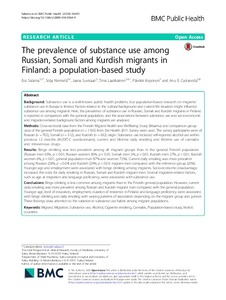The prevalence of substance use among Russian, Somali and Kurdish migrants in Finland: a population-based study
Solja Niemelä; Anu E Castaneda; Tiina Laatikainen; Jaana Suvisaari; Essi Salama; Päivikki Koponen
https://urn.fi/URN:NBN:fi-fe2021042719053
Tiivistelmä
Background
Substance use is a well-known public health problem, but population-based research on migrants’ substance use in Europe is limited. Factors related to the cultural background and current life situation might influence substance use among migrants. Here, the prevalence of substance use in Russian, Somali and Kurdish migrants in Finland is reported in comparison with the general population, and the associations between substance use and socio-economic and migration-related background factors among migrants are analysed.
Methods
Cross-sectional data from the Finnish Migrant Health and Wellbeing Study (Maamu) and comparison group data of the general Finnish population (n = 1165) from the Health 2011 Survey were used. The survey participants were of Russian (n = 702), Somali (n = 512), and Kurdish (n = 632) origin. Substance use included self-reported alcohol use within previous 12 months (AUDIT-C questionnaire), current and lifetime daily smoking and lifetime use of cannabis and intravenous drugs.
Results
Binge drinking was less prevalent among all migrant groups than in the general Finnish population (Russian men 65%, p < 0.01; Russian women 30%, p < 0.01, Somali men 2%, p < 0.01, Kurdish men 27%, p < 0.01, Kurdish women 6%, p < 0.01, general population men 87% and women 72%). Current daily smoking was more prevalent among Russian (28%, p = 0.04) and Kurdish (29%, p < 0.01) migrant men compared with the reference group (20%). Younger age and employment were associated with binge drinking among migrants. Socio-economic disadvantage increased the odds for daily smoking in Russian, Somali and Kurdish migrant men. Several migration-related factors, such as age at migration and language proficiency, were associated with substance use.
Conclusions
Binge drinking is less common among migrants than in the Finnish general population. However, current daily smoking was more prevalent among Russian and Kurdish migrant men compared with the general population. Younger age, level of education, employment, duration of residence in Finland and language proficiency were associated with binge drinking and daily smoking with varying patterns of association depending on the migrant group and gender. These findings draw attention to the variation in substance use habits among migrant populations.
Kokoelmat
- Rinnakkaistallenteet [19207]
